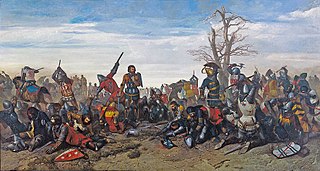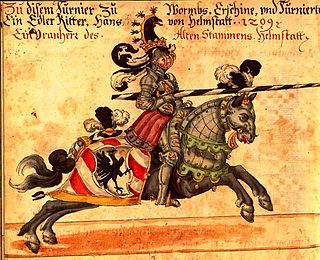 W
WA tournament, or tourney, was a chivalrous competition or mock fight in the Middle Ages and Renaissance. It is one type of hastilude. The shows were held often because of coronations, the marriage of kings, births, baptisms, weddings of princesses, conquests, peace, alliances, welcoming ambassadors or people of great worth, and even other minor events, experienced by the nobility. Over time the ecclesiastical festivities were also solemnized with them, of which there is a very marked testimony in the chronicle of Don Pero Niño: When he ordered to perform very honorable parties and processions, he ordered to perform jousts and tournaments and games of reeds and gave weapons and horses and rich clothes and garrisons to those who were to make these things.
 W
WThe Combat of the Thirty was an episode in the Breton War of Succession fought to determine who would rule the Duchy of Brittany. It was an arranged fight between selected combatants from both sides of the conflict, fought at a site midway between the Breton castles of Josselin and Ploërmel among 30 champions, knights, and squires on each side. The challenge was issued by Jean de Beaumanoir, a captain of Charles of Blois supported by King Philip VI of France, to Robert Bemborough, a captain of Jean de Montfort supported by Edward III of England.
 W
WAntoine de la Sale was a French courtier, educator and writer. He participated in a number of military campaigns in his youth and he only began writing when he had reached middle age, in the late 1430s. He lived in Italy at the time, but returned to France in the 1440s, where he acted as umpire in tournaments, and he wrote a treatise on the history of the knightly tournament in 1459. He became the tutor of the sons of Louis de Luxembourg, Count of Saint-Pol, to whom he dedicated a moral work in 1451. His most successful work was Little John of Saintré, written in 1456, when he was reaching the age of seventy.
 W
WFreydal is an uncompleted illustrated prose narrative commissioned by the Holy Roman Emperor, Maximilian I in the early 16th century. It was intended to be a romantic allegorical account of Maximilian's own participation in a series of jousting tournaments in the guise of the tale's eponymous hero, Freydal. In the story, Freydal takes part in the tournaments to prove that he is worthy to marry a princess, who is a fictionalised representation of Maximilian's late wife, Mary of Burgundy.
 W
WAgnes Hotot was an English noblewoman known for besting a man in a lance fight. According to Arthur Collins writing in 1741, an unspecified monk recorded that Hotot took her father's place in a duel after he fell ill, disguising herself as a man, and only revealed her true identity after knocking her opponent off his horse. When Hotot later married into the Dudley family of Clapton, Northhamptonshire, the Dudleys commemorated her exploits with a new crest depicting a woman wearing a war helmet.
 W
WJean III d'Aa, lord of Gruuthuse was a Flemish-Burgundian knight of the Bruges noble family of Gruuthuse. He is notable for having fought a great tournament in Bruges on 11 March 1393 against his cousin, Jean de Ghistelle, lord of Gistel and Harnes. Jean was also the grandfather of Louis de Gruuthuse, himself a "bulwark of Burgundian chivalry" and a notable participant in tournaments in the 1440s.
 W
WLe Livre des tournois or King René's Tournament Book is a treatise describing rules for tournaments by the French prince René d'Anjou. It is best known from what appears to be Rene's own illuminated copy from the 1460s, now in the Bibliothèque Nationale, Paris with illustrations, or at least the drawings before colouring, attributed to Barthélemy d'Eyck.
 W
WA tournament, or tourney, was a chivalrous competition or mock fight in the Middle Ages and Renaissance. It is one type of hastilude. The shows were held often because of coronations, the marriage of kings, births, baptisms, weddings of princesses, conquests, peace, alliances, welcoming ambassadors or people of great worth, and even other minor events, experienced by the nobility. Over time the ecclesiastical festivities were also solemnized with them, of which there is a very marked testimony in the chronicle of Don Pero Niño: When he ordered to perform very honorable parties and processions, he ordered to perform jousts and tournaments and games of reeds and gave weapons and horses and rich clothes and garrisons to those who were to make these things.
 W
WThe Thurnierbuch, published in 1530, is an important work on the tradition of medieval tournaments in the Holy Roman Empire.